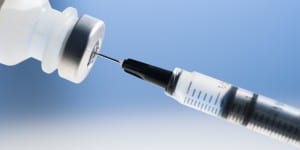 In 2006, the Food and Drug Administration (FDA) approved a vaccine for adolescent girls and young adult women that protects against the human papillomavirus (HPV) – a sexually transmitted virus that can cause several cancer types, including cervical cancer. In 2009, the FDA approved the vaccine for adolescent boys and young adult men.
In 2006, the Food and Drug Administration (FDA) approved a vaccine for adolescent girls and young adult women that protects against the human papillomavirus (HPV) – a sexually transmitted virus that can cause several cancer types, including cervical cancer. In 2009, the FDA approved the vaccine for adolescent boys and young adult men.
The US government recommends an 80% vaccination rate by 2020, but current rates for the 3-dose series among US adolescents is well below this rate (39.7% for girls, 21.6% for boys), particularly among traditionally underserved adolescents seen in safety-net clinics (uninsured, low-income, and racial and ethnic minorities). Thus, low vaccination rates are an important public health issue.
In a paper our group recently published in the journal JMIR Research Protocols, we describe an innovative project designed to address the problem of suboptimal HPV vaccination rates in safety-net pediatric clinics. Self-persuasion, the process of generating one’s own arguments for engaging in a specific behavior, is an effective behavior change strategy. Moreover, it may be a particularly useful strategy for adolescent HPV vaccination because many parents of adolescents are undecided or ambivalent about the vaccine. Leveraging parents’ own arguments for the vaccine may help to address their indecision or ambivalence. However, it is not yet known how to develop and implement self-persuasion for HPV vaccination in a safety-net clinic setting.
In the paper, we describe the 3-stage project that is funded by the National Cancer Institute to develop and implement a self-persuasion intervention for adolescent HPV vaccination. In the intervention, we will use an iPad application we developed to help parents learn about HPV and the vaccine and to think about and verbalize their own reasons for why getting the vaccine is important. The three stages of the project all have a distinct purpose. In Stage 1, we have conducted formative studies to understand parents’ ability to generate their own arguments for HPV vaccination and to understand how parents and healthcare providers discuss the vaccine with one another. In Stage 2, we will conduct a randomized intervention to understand what aspects of self-persuasion (verbalization, choosing argument topics) are most effective and to identify the optimal approach to self-persuasion in this population. In Stage 3, we will conduct a pilot trial to establish the feasibility of using the iPad-based intervention before a clinic appointment and to determine its effect on parent-provider discussions about the vaccine.
This project is an excellent example of an integration of basic and applied behavioral science to address an important public health issue. From a basic science perspective, the project uses an effective behavior change approach in an innovative way. Plus, the findings from the study will add to our understanding which aspects of self-persuasion are most effective. From an applied science perspective, the project will result a feasible intervention that can be realistically implemented in pediatric clinics. This type of collaboration between basic and applied behavioral science is important to advancing our understanding of how best to address important health issues, like HPV vaccination.
Reference. Tiro, J.A., Lee, S.C., Marks, E.G., Persaud, D., Skinner, C.S., Street, R.L., Wiebe, D.J., Farrell, D., Bishop, W.P., Fuller, S., & Baldwin, A.S. (2016). Developing a tablet-based self-persuasion intervention promoting adolescent HPV vaccination: Protocol for a three-stage mixed-methods study. JMIR Research Protocols, 5, e19.